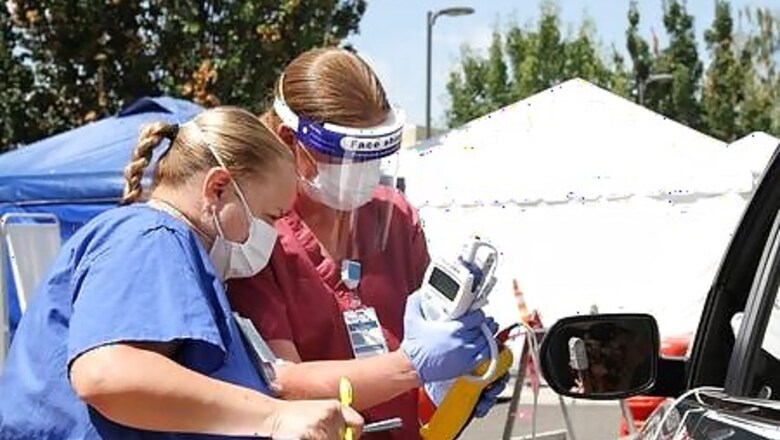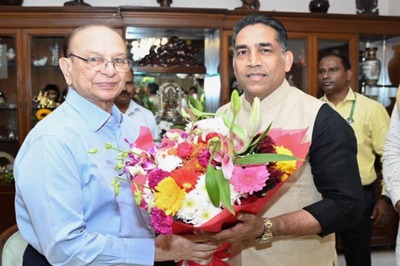
views
SACRAMENTO, Calif. All day long, as Air Force nurse Major Pinky Brewton cares for patients struggling to breathe in California’s COVID-19 ravaged San Joaquin Valley, fears for her family simmer underneath her cool exterior.
Once back in her Stockton hotel room, seeing her seven-year-old on Facetime, the relief is overwhelming.
“He’s breathing!” Brewton said. “That’s the first thing I see as a nurse. How well is my son breathing?”
Over the past two weeks, the U.S. Department of Defense has sent nearly 200 medics and logistics experts to the Valley. The military has also sent nearly 600 personnel to Texas, where a surge in COVID-19 cases is crushing hospitals along the Rio Grande Valley and elsewhere in the state.
The teams of nurses, doctors and technicians work extra shifts, treating sicker-than-usual hospital patients. Many are so weak from oxygen deprivation they can barely eat.
In the San Joaquin Valley agricultural region, intensive care units overflowed as cases surged earlier this summer. In some counties, as many as 28% of test results were positive.
At Dameron hospital in Stockton near the state capital of Sacramento, every nurse was soon deployed on a new COVID-19 floor, said Jennifer Markovich, the facility’s chief nursing officer.
“There wasn’t a slow rampup. In the space of two weeks we just saw a significant increase in patients … and really started to see those staffing needs really escalate.”
CHAPLAINS, MENTAL HEALTH EXPERTS
When staffing agencies lacked healthcare workers, the hospital turned to the state, Markovich said. Under the Federal Emergency Management Agency, Brewton’s team of 20 military nurses and respiratory therapists came on board in mid-July.
About 160 Air Force medical staff have been sent to California so far, with about 100 in San Joaquin Valley, coordinated by 25 U.S. Army logistics experts trained in responding to nuclear, chemical and biological attacks.
Chaplains and mental health experts were added to relieve stress in a system stretched to its limits.
The teams, mostly stationed at Travis Air Force Base north of San Francisco, were easily absorbed into the rotations and work cultures of the Valley hospitals, said Lieutenant Colonel Ryan Gassman, who commands the California teams.
“It’s not like we have any Air Force tents that are set up outside,” Gassman said. “We are truly jumping into the staff in each of these hospitals to help support in any way, shape or form that we can.”
In addition to five hospitals in the San Joaquin Valley, military teams have also been deployed to the Los Angeles area and Rancho Mirage in Riverside County east of Los Angeles.
COVID-19 cases in California began climbing after Memorial Day, which health officials attributed in part to family gatherings without masks or physical distancing measures. Statewide, cases have topped 500,000, and over 9,000 Californians have died.
California, Texas, Florida and Arizona are among several hotspot U.S. states for a second wave of coronavirus cases.
FRAGILE HOSPITALS
In the San Joaquin Valley, a perfect storm of cultural, political and economic issues led to a crush of cases in a fragile rural and smaller-city hospital system.
The region is heavily Latino, a group making up 39% of California’s population but accounts for 56% of COVID-19 infections and 46% of deaths in the most populous U.S. state. Agricultural businesses that have not provided protective equipment to workers, or implemented social distancing or rules requiring masks has led to increased infections. Large family gatherings and multi-generational households have led to fast and deadly transmission, often to vulnerable older relatives.
The Valley, which includes the oil drilling and agricultural area around Bakersfield, and farmlands around Fresno, is generally more conservative than the rest of the state, and many local and congressional leaders have opposed rules requiring masks and social distancing.
The resulting toll is stark. As of Friday, only 20 intensive care unit beds were available for new patients in all of San Joaquin County, which has a population of nearly 800,000.
“The first thing I saw were really, really sick patients,” nurse Brewton said, describing her first day at Dameron. “The acuity of these patients are far more than what we see on a typical medical floor.”
Disclaimer: This post has been auto-published from an agency feed without any modifications to the text and has not been reviewed by an editor



















Comments
0 comment